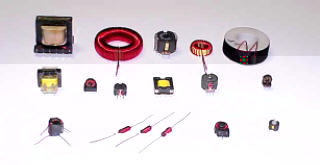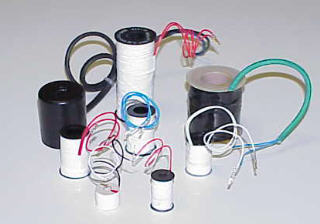



Visitors: Come In and have a look around! this is the place.
|
|
|
An inductor is an energy storage device. It can be as simple as a single loop of wire or consist of many turns of wire wound around a special core. Energy is stored in the form of a magnetic field in or around the inductor. Whenever current flows through a wire, it creates a magnetic field around the wire. By placing multiple turns of wire around a loop, we concentrate the magnetic field into a smal|er space where it can be more useful. When you apply a voltage across an inductor, a current starts to flow. It does not instantly rise to some level, but rather increases gradually over time. The relationship of voltage to current vs. time gives rise to a property called inductance. The higher the inductance, the longer it takes for a given voltage to produce a given current. Whenever there is a moving or changing magnetic field in the presence of an inductor, that change attempts to generate a current in the inductor. An externally applied current produces an increasing magnetic field which in turn produces a current opposing that applied externally, hence the inability to create an instantaneous current change in an inductor. This property makes inductors useful as filters in power supplies. Many types of cores are commonly used in inductors. The simplest core is basically nothing, or air. Any core consisting of non-magnetic material behaves essentially the same as air. Most commonly used inductors, however, use some type of magnetic material in the core. This tends to concentrate the inductor’s magnetic field inside the core and increases the effective inductance. While a magnetic core can provide greater inductance in a given volume, there are also drawbacks. A magnetic core can contain only a limited magnetic field. As you increase current in a magnetic core inductor, the magnetic field increases. At some point, further increasing the current no longer produces an increase in the magnetic field. At this point, the core is said to be saturated, a condition that generally is undesirable. The relationship between the inductance with a given core and the number of turns on it is called its AL value. The unit of inductance is the henry. The formula for inductance is: L = n2(squared) x AL where L is the inductance in henries and n is the number of turns. Most commercially available cores have published AL values. Inductor cores with higher AL values tend to saturate more readily than cores with lower AL values. Written by Les Beckwith Copyright of General Linear Systems |
|
*************************************************************************************************** General Linear Systems 4332 Artesia Blv. Fullerton Ca. 92833 Ph: 1 ( 714 ) 994 - 4822 Fax : 1 ( 714 ) 994 - 4823 Email us at: This E-mail Link Send mail to
coilwinding@earthlink.net with questions or comments about
this web site.
|